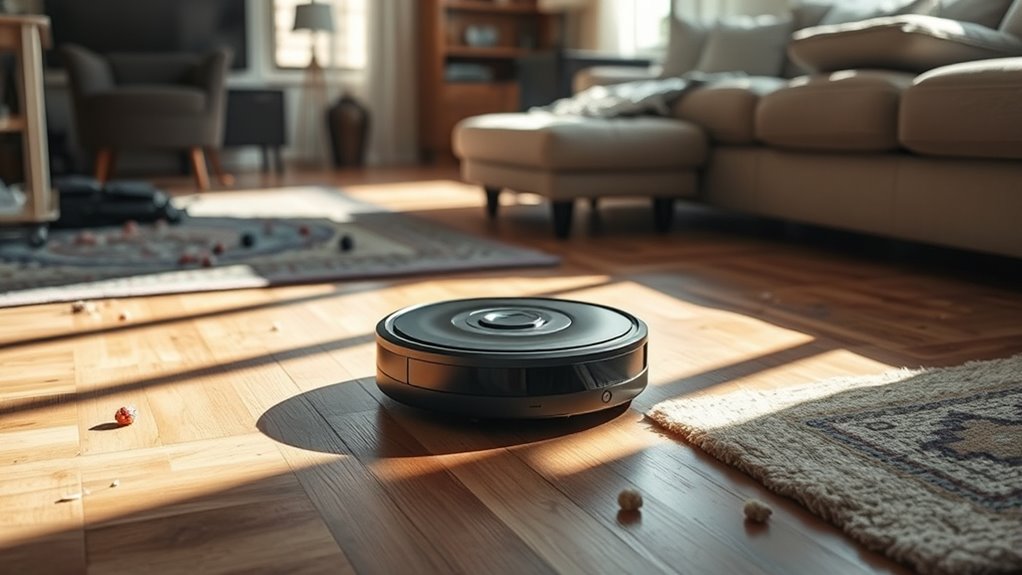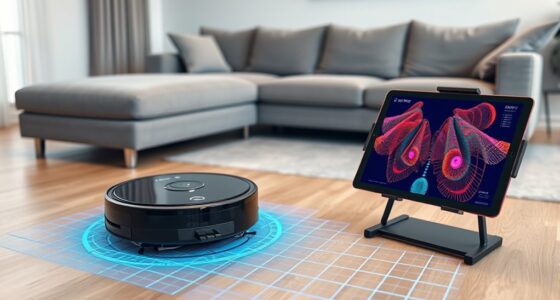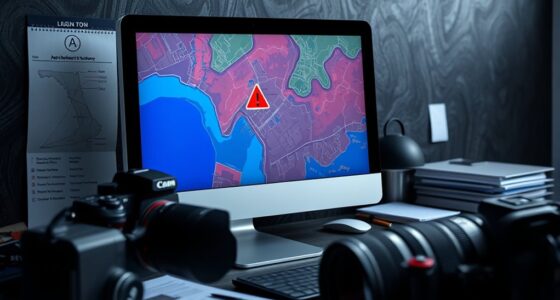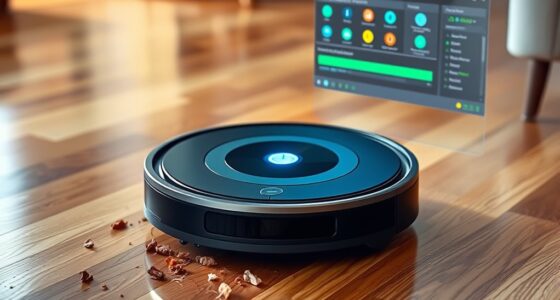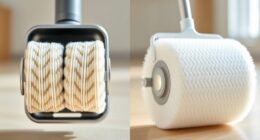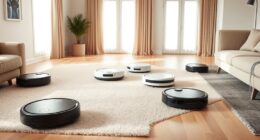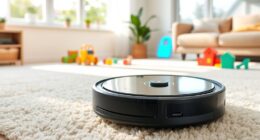If your robot vacuum is missing spots or getting lost, you might be making common mapping mistakes like cluttered floors or unclear virtual boundaries. Poor lighting, reflective surfaces, or complex layouts can confuse sensors and cause navigation errors. Failing to clear obstacles or set no-go zones also impacts coverage. Regularly cleaning sensors and properly configuring zones can improve results. Keep these tips in mind, and you’ll discover even more ways to optimize your robot’s mapping ability.
Key Takeaways
- Ensure the home is well-lit and free of reflective surfaces to prevent sensor confusion during mapping.
- Regularly clean sensors and remove clutter like cords and small objects for accurate obstacle detection.
- Use app features to set virtual boundaries and no-go zones to avoid problematic or hard-to-map areas.
- Update the robot’s firmware to improve mapping accuracy and reduce navigation errors.
- Clear clutter and obstacles before cleaning to enhance coverage and prevent the robot from getting lost or misreading obstacles.

Robot vacuums have revolutionized home cleaning, but they can sometimes make mistakes when mapping your space. One common issue you might encounter involves navigation errors that prevent your device from effectively understanding your home’s layout. These errors often happen when the vacuum’s sensors and algorithms struggle to interpret the environment accurately. For example, if the robot receives inconsistent signals or if the layout is complex, it may create a faulty map or get lost mid-clean. This not only wastes time but can also leave some areas untouched. To improve navigation, confirm your floors are well-lit and free of reflective surfaces that can confuse sensors. Regularly update the vacuum’s firmware, as manufacturers often release improvements that enhance mapping accuracy and reduce navigation errors.
Obstacle detection is another vital factor that impacts the robot’s ability to map your space correctly. Many vacuums rely on sensors to detect furniture, walls, and other objects, but these sensors aren’t foolproof. Sometimes, the robot might misjudge an obstacle’s position or size, resulting in collisions or missed spots. For instance, a cluttered room with tangled cords or small objects can fool obstacle detection systems, causing the vacuum to bump into things or avoid certain areas altogether. This can lead to incomplete coverage and poor mapping data. To prevent this, clear clutter from floors before starting a cleaning cycle, and consider placing protective covers over sensitive sensors if your model offers this option. Proper obstacle detection also depends on the robot’s ability to interpret sensor data correctly, so keep sensors clean and dust-free for maximum performance.
Another mistake you might make is not setting up virtual boundaries or no-go zones, which can lead to navigation errors especially in complex environments. When the robot doesn’t have restrictions set, it may attempt to access areas that are difficult to map or contain obstacles, increasing the chances of errors. Using the app to designate restricted zones helps the robot avoid trouble spots and improves the overall accuracy of your home map.
Frequently Asked Questions
How Often Should I Reset My Robot Vacuum’S Mapping Data?
You should reset your robot vacuum’s mapping data only when necessary. Typically, a good mapping frequency is every few months or if you notice navigation issues. Follow a reset schedule if your home layout changes or obstacles block your robot’s path. Resetting too often can cause confusion, so only do it when your vacuum struggles to map or clean efficiently. This keeps your robot’s performance ideal without unnecessary resets.
Can Multiple Floor Types Confuse My Robot Vacuum’S Map?
Multiple floor types can indeed cause your robot vacuum to experience multi floor confusion, leading to mapping inconsistencies. When your robot encounters different surfaces or floor heights, it might struggle to create accurate maps, affecting navigation. To prevent this, you should manually set specific zones or floors if your vacuum has this feature, and avoid frequent changes in the environment. Regularly updating your maps helps maintain accurate navigation across various floor types.
Does Clutter Affect the Mapping Accuracy of My Robot Vacuum?
Clutter can cause chaos for your robot vacuum, almost like a hurricane swirling around your home. It greatly impacts mapping accuracy, as clutter impact makes it harder for your robot to recognize and remember the layout. Obstacle interference from clutter can block sensors, leading to missed spots or wrong turns. To guarantee your vacuum navigates effectively, keep surfaces clear, allowing it to do its job flawlessly and avoid unnecessary mishaps.
How Do I Update My Robot Vacuum’S Firmware for Better Mapping?
To improve your robot vacuum’s mapping, you should regularly check for firmware updates. Firmware updates often include mapping improvements and bug fixes that enhance navigation accuracy. To do this, open your app, connect to your vacuum, and follow the instructions to download and install any available updates. Keeping your firmware current guarantees better mapping performance, helping your vacuum navigate more efficiently and clean your space thoroughly.
Are There Specific Home Layouts That Hinder Robot Vacuum Mapping?
Imagine trying to map a cluttered home with a complex floor plan and numerous obstacle placements, like furniture and rugs. These layouts can confuse your robot vacuum, causing it to miss spots or create incomplete maps. Narrow hallways, open-concept areas, or irregularly shaped rooms are especially challenging. To improve mapping, simplify obstacle placement and guarantee your vacuum has a clear, unobstructed path.
Conclusion
Now that you know the common mapping mistakes, you can avoid them and guarantee your robot vacuum navigates like a pro. Think of your vacuum’s mapping ability as a GPS for your home—without proper guidance, it’s easy to get lost. By fixing these errors, you’ll keep your space cleaner and your device running smoothly. Don’t let simple mistakes trip up your cleaning routine; instead, give your robot the tools to succeed, just like a trusted map guides a traveler.
